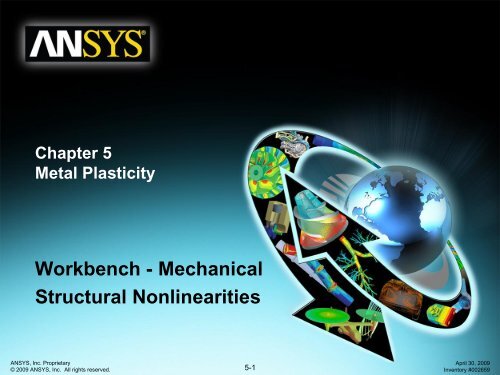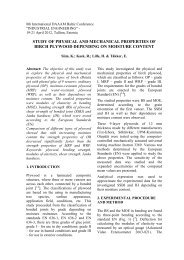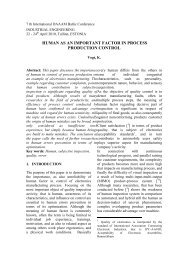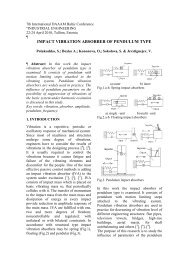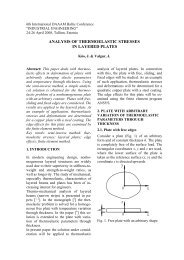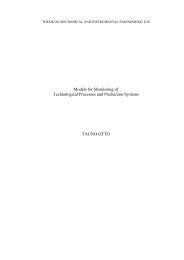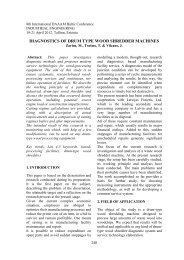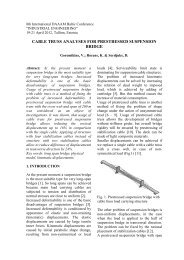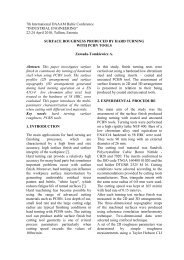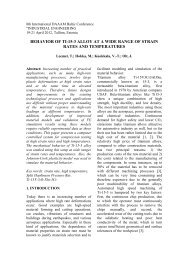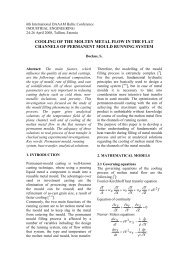Workbench Mechanical â Metal Plasticity
Workbench Mechanical â Metal Plasticity
Workbench Mechanical â Metal Plasticity
Create successful ePaper yourself
Turn your PDF publications into a flip-book with our unique Google optimized e-Paper software.
Chapter 5<br />
<strong>Metal</strong> <strong>Plasticity</strong><br />
<strong>Workbench</strong> - <strong>Mechanical</strong><br />
Structural Nonlinearities<br />
ANSYS, Inc. Proprietary<br />
© 2009 ANSYS, Inc. All rights reserved.<br />
5-1<br />
April 30, 2009<br />
Inventory #002659
<strong>Workbench</strong> <strong>Mechanical</strong> – <strong>Metal</strong> <strong>Plasticity</strong><br />
Chapter Overview<br />
Training Manual<br />
• The following will be covered in this Chapter:<br />
– Background Elasticity/<strong>Plasticity</strong><br />
– Theory<br />
• Yield Criteria<br />
• Hardening Rule<br />
– Procedure<br />
– Workshop<br />
• The capabilities described in this section are generally applicable to<br />
ANSYS Structural licenses and above.<br />
– Exceptions will be noted accordingly<br />
ANSYS, Inc. Proprietary<br />
© 2009 ANSYS, Inc. All rights reserved.<br />
5-2<br />
April 30, 2009<br />
Inventory #002659
<strong>Workbench</strong> <strong>Mechanical</strong> – <strong>Metal</strong> <strong>Plasticity</strong><br />
A. <strong>Metal</strong> <strong>Plasticity</strong> Overview<br />
Training Manual<br />
What is plasticity?<br />
• When a ductile material experiences stresses beyond the elastic limit,<br />
it will yield, acquiring large permanent deformations.<br />
– <strong>Plasticity</strong> refers to the material response beyond yield.<br />
– Plastic response is important for metal forming operations.<br />
– <strong>Plasticity</strong> is also important as an energy-absorbing mechanism for<br />
structures in service.<br />
• Materials that fail with little plastic deformation are said to be brittle.<br />
• Ductile response is safer in many respects than is brittle response.<br />
• This Chapter will review some basics of plasticity by defining certain<br />
terminology.<br />
ANSYS, Inc. Proprietary<br />
© 2009 ANSYS, Inc. All rights reserved.<br />
5-3<br />
April 30, 2009<br />
Inventory #002659
<strong>Workbench</strong> <strong>Mechanical</strong> – <strong>Metal</strong> <strong>Plasticity</strong><br />
... <strong>Metal</strong> <strong>Plasticity</strong> Overview<br />
Training Manual<br />
Review of Elasticity:<br />
• Before proceeding to a discussion on plasticity, it may be useful to<br />
review elasticity of metals.<br />
– In elastic response, if the induced stresses are below the material‟s yield<br />
strength, the material can fully recover its original shape upon unloading.<br />
– From a standpoint of metals, this behavior is due to the stretching but not<br />
breaking of chemical bonds between atoms. Because elasticity is due to<br />
this stretching of atomic bonds, it is fully recoverable. Moreover, these<br />
elastic strains tend to be small.<br />
– Elastic behavior of metals is most commonly described by the stressstrain<br />
relationship of Hooke‟s Law:<br />
E<br />
ANSYS, Inc. Proprietary<br />
© 2009 ANSYS, Inc. All rights reserved.<br />
5-4<br />
April 30, 2009<br />
Inventory #002659
<strong>Workbench</strong> <strong>Mechanical</strong> – <strong>Metal</strong> <strong>Plasticity</strong><br />
... <strong>Metal</strong> <strong>Plasticity</strong> Overview<br />
Training Manual<br />
Review of <strong>Plasticity</strong>:<br />
• Plastic deformation results from slip between planes of atoms due to<br />
shear stresses (deviatoric stresses). This dislocation motion is<br />
essentially atoms in the crystal structure rearranging themselves to<br />
have new neighbors<br />
– results in unrecoverable strains or permanent deformation after load is<br />
removed.<br />
– slipping does not generally result in any volumetric strains (condition of<br />
incompressibility), unlike elasticity<br />
<br />
Yield Strength y<br />
Unloading<br />
Elastic<br />
Plastic<br />
<br />
ANSYS, Inc. Proprietary<br />
© 2009 ANSYS, Inc. All rights reserved.<br />
5-5<br />
April 30, 2009<br />
Inventory #002659
<strong>Workbench</strong> <strong>Mechanical</strong> – <strong>Metal</strong> <strong>Plasticity</strong><br />
... <strong>Metal</strong> <strong>Plasticity</strong> Overview<br />
Training Manual<br />
Rate-Independent <strong>Plasticity</strong>:<br />
• If the material response is not dependent on the rate of loading or<br />
deformation, the material is said to be rate-independent.<br />
– Most metals exhibit rate-independent behavior at low temperatures (< 1/4<br />
or 1/3 melting temperature) and low strain rates.<br />
Engineering vs. True Stress-Strain:<br />
• While engineering stress-strain can be used for small-strain<br />
analyses, true stress-strain must be used for plasticity, as they are<br />
more representative measures of the state of the material.<br />
ANSYS, Inc. Proprietary<br />
© 2009 ANSYS, Inc. All rights reserved.<br />
5-6<br />
April 30, 2009<br />
Inventory #002659
<strong>Workbench</strong> <strong>Mechanical</strong> – <strong>Metal</strong> <strong>Plasticity</strong><br />
... <strong>Metal</strong> <strong>Plasticity</strong> Overview<br />
Training Manual<br />
Engineering vs. True Stress-Strain (cont‟d):<br />
• If presented with engineering stress-strain data, one can convert these values<br />
to true stress-strain with the following approximations:<br />
– Up until twice the strain at which yielding occurs:<br />
eng<br />
– Up until the point at which necking occurs:<br />
<br />
<br />
<br />
<br />
eng<br />
1 ln1<br />
<br />
eng<br />
eng<br />
eng<br />
– Note that, only for stress conversion, the following is assumed:<br />
• Material is incompressible (acceptable approximation for large strains)<br />
• Stress distribution across cross-section of specimen is assumed to be uniform.<br />
– Beyond necking:<br />
• There is no conversion equation relating engineering to true stress-strain at<br />
necking. The instantaneous cross-section must be measured.<br />
ANSYS, Inc. Proprietary<br />
© 2009 ANSYS, Inc. All rights reserved.<br />
5-7<br />
April 30, 2009<br />
Inventory #002659
<strong>Workbench</strong> <strong>Mechanical</strong> – <strong>Metal</strong> <strong>Plasticity</strong><br />
B. Yield Criterion<br />
Training Manual<br />
Yield Criterion:<br />
• The yield criteria is used to relate multiaxial stress state with the<br />
uniaxial case.<br />
– Tensile testing on specimens provide uniaxial data, which can easily<br />
be plotted on one-dimensional stress-strain curves, such as those<br />
presented earlier in this section.<br />
– The actual structure usually exhibits multiaxial stress state. The yield<br />
criterion provides a scalar invariant measure of the stress state of the<br />
material which can be compared with the uniaxial case.<br />
ANSYS, Inc. Proprietary<br />
© 2009 ANSYS, Inc. All rights reserved.<br />
5-8<br />
April 30, 2009<br />
Inventory #002659
<strong>Workbench</strong> <strong>Mechanical</strong> – <strong>Metal</strong> <strong>Plasticity</strong><br />
... Yield Criterion<br />
Training Manual<br />
• In general, a stress state can be separated into two components.<br />
– Hydrostatic stress - generates volume change.<br />
– Deviatoric stress - generates angular distortion.<br />
1<br />
p<br />
1 - p<br />
= +<br />
2<br />
3<br />
p<br />
p<br />
2 - p<br />
3 - p<br />
Stress State<br />
(Where: 1 2 3 )<br />
Hydrostatic stress (p) causing<br />
volume change only<br />
Deviatoric stress causing<br />
angular distortion only<br />
ANSYS, Inc. Proprietary<br />
© 2009 ANSYS, Inc. All rights reserved.<br />
5-9<br />
April 30, 2009<br />
Inventory #002659
<strong>Workbench</strong> <strong>Mechanical</strong> – <strong>Metal</strong> <strong>Plasticity</strong><br />
… Yield Criterion<br />
Training Manual<br />
• The von Mises yield criterion predicts that yielding will occur<br />
whenever the distortion energy in a unit volume equals the<br />
distortion energy in the same volume when uniaxially stressed to<br />
the yield strength.<br />
– From this theory, a scalar invariant (von Mises equivalent stress) is<br />
derived as:<br />
<br />
e<br />
<br />
1<br />
2<br />
2<br />
2<br />
<br />
<br />
<br />
<br />
<br />
1<br />
2<br />
2<br />
3<br />
3<br />
1<br />
2<br />
<br />
• When von Mises equivalent stress exceeds the uniaxial material<br />
yield strength, general yielding will occur.<br />
ANSYS, Inc. Proprietary<br />
© 2009 ANSYS, Inc. All rights reserved.<br />
5-10<br />
April 30, 2009<br />
Inventory #002659
<strong>Workbench</strong> <strong>Mechanical</strong> – <strong>Metal</strong> <strong>Plasticity</strong><br />
... Yield Criterion<br />
Training Manual<br />
• If plotted in 3D principal stress space, the von Mises yield surface is a<br />
cylinder.<br />
The cylinder is aligned with the<br />
axis 1 = 2 = 3 .<br />
Note that if the stress state is<br />
inside the cylinder, no yielding<br />
occurs. This means that if the<br />
material is under hydrostatic<br />
pressure ( 1 = 2 = 3 ), no amount<br />
of hydrostatic pressure will<br />
cause yielding.<br />
Another way to view this is that<br />
stresses which deviate from<br />
the axis ( 1 = 2 = 3 ) contribute<br />
to the von Mises stress<br />
calculation.<br />
2<br />
1<br />
3<br />
1 2 3<br />
ANSYS, Inc. Proprietary<br />
© 2009 ANSYS, Inc. All rights reserved.<br />
5-11<br />
April 30, 2009<br />
Inventory #002659
<strong>Workbench</strong> <strong>Mechanical</strong> – <strong>Metal</strong> <strong>Plasticity</strong><br />
… Yield Criterion<br />
• At the edge of the cylinder (circle), yielding will occur.<br />
Training Manual<br />
• No stress state can exist outside of the cylinder.<br />
• Instead, hardening rules will describe how the cylinder changes<br />
with respect to yielding.<br />
1 <br />
Plastic<br />
y<br />
Elastic<br />
2 <br />
Principal Stress Space 3 Uniaxial Stress-Strain<br />
<br />
ANSYS, Inc. Proprietary<br />
© 2009 ANSYS, Inc. All rights reserved.<br />
5-12<br />
April 30, 2009<br />
Inventory #002659
<strong>Workbench</strong> <strong>Mechanical</strong> – <strong>Metal</strong> <strong>Plasticity</strong><br />
C. Hardening Rules<br />
Training Manual<br />
• The hardening rule describes how the yield surface changes (size,<br />
center,shape) as the result of plastic deformation.<br />
• The hardening rule determines when the material will yield again if<br />
the loading is continued or reversed.<br />
– This is in contrast to elastic-perfectly-plastic materials which exhibit no<br />
hardening -- i.e., the yield surface remains fixed.<br />
Plastic<br />
Elastic<br />
Yield Surface after Loading<br />
Initial Yield Surface<br />
ANSYS, Inc. Proprietary<br />
© 2009 ANSYS, Inc. All rights reserved.<br />
5-13<br />
April 30, 2009<br />
Inventory #002659
<strong>Workbench</strong> <strong>Mechanical</strong> – <strong>Metal</strong> <strong>Plasticity</strong><br />
… Hardening Rules<br />
Training Manual<br />
• There are two basic hardening rules to prescribe the modification of<br />
the yield surface:<br />
– Kinematic hardening.<br />
• The yield surface remains constant<br />
in size and translates in the<br />
direction of yielding.<br />
– Isotropic hardening.<br />
• The yield surface expands<br />
uniformly in all directions with<br />
plastic flow.<br />
2<br />
2<br />
Subsequent Yield<br />
Surface<br />
1<br />
Initial Yield<br />
Surface<br />
Subsequent Yield<br />
Surface<br />
Initial Yield<br />
Surface<br />
1<br />
• Most metals exhibit kinematic hardening behavior for small<br />
strain cyclic loading.<br />
ANSYS, Inc. Proprietary<br />
© 2009 ANSYS, Inc. All rights reserved.<br />
5-14<br />
April 30, 2009<br />
Inventory #002659
<strong>Workbench</strong> <strong>Mechanical</strong> – <strong>Metal</strong> <strong>Plasticity</strong><br />
… Kinematic Hardening<br />
• The stress-strain behavior for linear kinematic hardening is<br />
illustrated below:<br />
Initial Yield<br />
Surface<br />
3 <br />
Subsequent<br />
Yield Surface<br />
'<br />
y<br />
a<br />
2<br />
2 y<br />
<br />
Training Manual<br />
• Subsequent yield in compression is decreased by the amount that<br />
the yield stress in tension increased, so that a 2 y difference<br />
between the yields is always maintained. (This is known as the<br />
Bauschinger effect.)<br />
ANSYS, Inc. Proprietary<br />
© 2009 ANSYS, Inc. All rights reserved.<br />
5-15<br />
April 30, 2009<br />
Inventory #002659
<strong>Workbench</strong> <strong>Mechanical</strong> – <strong>Metal</strong> <strong>Plasticity</strong><br />
… Kinematic Hardening<br />
Training Manual<br />
• An initially isotropic material is no longer isotropic after it yields and<br />
experiences kinematic hardening.<br />
• For very large strain simulations, the kinematic hardening model can<br />
become inappropriate because of the Bauschinger effect.<br />
‟<br />
y<br />
2<br />
y<br />
<br />
• Kinematic hardening is generally used for small strain, cyclic loading<br />
applications.<br />
ANSYS, Inc. Proprietary<br />
© 2009 ANSYS, Inc. All rights reserved.<br />
5-16<br />
April 30, 2009<br />
Inventory #002659
<strong>Workbench</strong> <strong>Mechanical</strong> – <strong>Metal</strong> <strong>Plasticity</strong><br />
… Isotropic Hardening<br />
Training Manual<br />
• Isotropic hardening states that the yield surface expands uniformly<br />
during plastic flow. The term „isotropic‟ refers to the uniform<br />
dilatation of the yield surface and is different from an „isotropic‟ yield<br />
criterion (i.e., material orientation).<br />
Subsequent<br />
Yield Surface<br />
Initial Yield<br />
Surface<br />
1 <br />
'<br />
y<br />
3<br />
2'<br />
<br />
ANSYS, Inc. Proprietary<br />
© 2009 ANSYS, Inc. All rights reserved.<br />
5-17<br />
April 30, 2009<br />
Inventory #002659
<strong>Workbench</strong> <strong>Mechanical</strong> – <strong>Metal</strong> <strong>Plasticity</strong><br />
… Isotropic Hardening<br />
Training Manual<br />
• Plotting the stress-strain curve enables an understanding of what<br />
occurs during a loading and reverse loading cycle:<br />
<br />
‟<br />
y<br />
2 ‟<br />
<br />
Note that the subsequent<br />
yield in compression is<br />
equal to the highest stress<br />
attained during the tensile<br />
phase.<br />
Isotropic hardening is often<br />
used for large strain or<br />
proportional loading<br />
simulations. It is usually<br />
not applicable for cyclic<br />
loading.<br />
ANSYS, Inc. Proprietary<br />
© 2009 ANSYS, Inc. All rights reserved.<br />
5-18<br />
April 30, 2009<br />
Inventory #002659
<strong>Workbench</strong> <strong>Mechanical</strong> – <strong>Metal</strong> <strong>Plasticity</strong><br />
D. Material Data Input<br />
Training Manual<br />
Curve shapes<br />
• Two different type of stress-strain curve representations are<br />
possible:<br />
<br />
<br />
<br />
Bilinear<br />
Multilinear<br />
<br />
ANSYS, Inc. Proprietary<br />
© 2009 ANSYS, Inc. All rights reserved.<br />
5-19<br />
April 30, 2009<br />
Inventory #002659
<strong>Workbench</strong> <strong>Mechanical</strong> – <strong>Metal</strong> <strong>Plasticity</strong><br />
... Material Data Input<br />
Training Manual<br />
• Linear elastic material properties must be supplied<br />
– The same requirements exist for linear static structural analyses, namely<br />
that Young‟s Modulus and Poisson‟s Ratio must be defined as a<br />
minimum.<br />
• <strong>Metal</strong> plasticity is available as a nonlinear material model. This will<br />
be discussed next.<br />
– Other nonlinear constitutive models may be added with Command<br />
Objects<br />
– Note that only ANSYS Professional NLS licenses and above support<br />
nonlinear material laws.<br />
ANSYS, Inc. Proprietary<br />
© 2009 ANSYS, Inc. All rights reserved.<br />
5-20<br />
April 30, 2009<br />
Inventory #002659
<strong>Workbench</strong> <strong>Mechanical</strong> – <strong>Metal</strong> <strong>Plasticity</strong><br />
... Material Data Input<br />
Training Manual<br />
• To add metal plasticity, first navigate to the project schematic.<br />
Highlight the Engineering Data branch, double click or RMB and<br />
click on Edit…<br />
ANSYS, Inc. Proprietary<br />
© 2009 ANSYS, Inc. All rights reserved.<br />
5-21<br />
April 30, 2009<br />
Inventory #002659
<strong>Workbench</strong> <strong>Mechanical</strong> – <strong>Metal</strong> <strong>Plasticity</strong><br />
... Material Data Input<br />
Training Manual<br />
• This opens the Engineering Data dialogue box for adding and editing<br />
various material properties related to the active project(s).<br />
ANSYS, Inc. Proprietary<br />
© 2009 ANSYS, Inc. All rights reserved.<br />
5-22<br />
April 30, 2009<br />
Inventory #002659
<strong>Workbench</strong> <strong>Mechanical</strong> – <strong>Metal</strong> <strong>Plasticity</strong><br />
... Material Data Input<br />
Training Manual<br />
• From the Toolbox, open the plasticity folder:<br />
– Highlight the metal plasticity model of interests (in the example below,<br />
Bilinear Isotropic is selected)<br />
– RMB on the material model and click on “Include Property”<br />
– The Bilinear Isotropic Hardening model<br />
will then appear in the Properties Dialogue box.<br />
– The yellow blank boxes are now available for user<br />
to define yield strength and tangent modulus.<br />
ANSYS, Inc. Proprietary<br />
© 2009 ANSYS, Inc. All rights reserved.<br />
5-23<br />
April 30, 2009<br />
Inventory #002659
<strong>Workbench</strong> <strong>Mechanical</strong> – <strong>Metal</strong> <strong>Plasticity</strong><br />
... Material Data Input<br />
Training Manual<br />
• After defining the yield strength and tangent modulus, the data will<br />
automatically be plotted graphically for inspection:<br />
ANSYS, Inc. Proprietary<br />
© 2009 ANSYS, Inc. All rights reserved.<br />
5-24<br />
April 30, 2009<br />
Inventory #002659
<strong>Workbench</strong> <strong>Mechanical</strong> – <strong>Metal</strong> <strong>Plasticity</strong><br />
... Material Data Input<br />
Training Manual<br />
• In a similar procedure, multilinear isotropic or kinematic hardening<br />
models can also be defined and verified:<br />
ANSYS, Inc. Proprietary<br />
© 2009 ANSYS, Inc. All rights reserved.<br />
5-25<br />
April 30, 2009<br />
Inventory #002659
<strong>Workbench</strong> <strong>Mechanical</strong> – <strong>Metal</strong> <strong>Plasticity</strong><br />
... Material Data Input<br />
Training Manual<br />
• Multilinear isotropic or kinematic hardening models also support<br />
temperature dependent properties<br />
ANSYS, Inc. Proprietary<br />
© 2009 ANSYS, Inc. All rights reserved.<br />
5-26<br />
April 30, 2009<br />
Inventory #002659
<strong>Workbench</strong> <strong>Mechanical</strong> – <strong>Metal</strong> <strong>Plasticity</strong><br />
… Summary of <strong>Plasticity</strong> in <strong>Mechanical</strong><br />
Training Manual<br />
• <strong>Metal</strong> plasticity deals with elastic and inelastic (permanent) deformation.<br />
Inelastic or plastic deformation occurs when the stress is higher than the<br />
yield strength. There will always be some recoverable strain (elastic strain)<br />
upon unloading.<br />
• A stress-strain curve is based on scalar data, usually from a uniaxial test. A<br />
system may undergo a multiaxial stress state, so Simulation uses the Mises<br />
yield criterion to relate a multiaxial stress state with scalar test data. In this<br />
situation, true stress vs. strain data should be supplied.<br />
• After yielding occurs, the yield point may increase due to strain hardening.<br />
This changes the yield surface, and the way in which it evolves in Simulation<br />
is determined by Isotropic or Kinematic hardening assumption.<br />
• The stress-strain curve can be represented by a bilinear or multilinear curve.<br />
ANSYS, Inc. Proprietary<br />
© 2009 ANSYS, Inc. All rights reserved.<br />
5-27<br />
April 30, 2009<br />
Inventory #002659
<strong>Workbench</strong> <strong>Mechanical</strong> – <strong>Metal</strong> <strong>Plasticity</strong><br />
E. Workshop – <strong>Metal</strong> <strong>Plasticity</strong><br />
Training Manual<br />
• Please refer to your Workshop Supplement for instructions on:<br />
– W5A-<strong>Metal</strong> <strong>Plasticity</strong><br />
ANSYS, Inc. Proprietary<br />
© 2009 ANSYS, Inc. All rights reserved.<br />
5-28<br />
April 30, 2009<br />
Inventory #002659
<strong>Workbench</strong> <strong>Mechanical</strong> – <strong>Metal</strong> <strong>Plasticity</strong><br />
... Workshop – <strong>Metal</strong> <strong>Plasticity</strong><br />
Training Manual<br />
• Please refer to your Workshop Supplement for instructions on:<br />
– W5B - Localized Yielding<br />
ANSYS, Inc. Proprietary<br />
© 2009 ANSYS, Inc. All rights reserved.<br />
5-29<br />
April 30, 2009<br />
Inventory #002659


